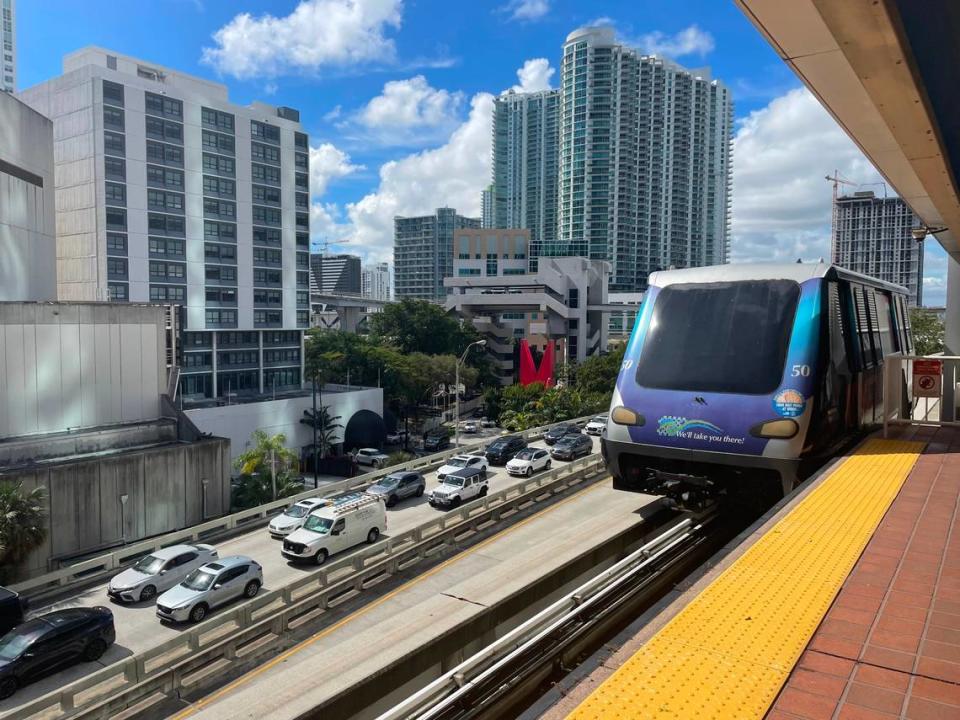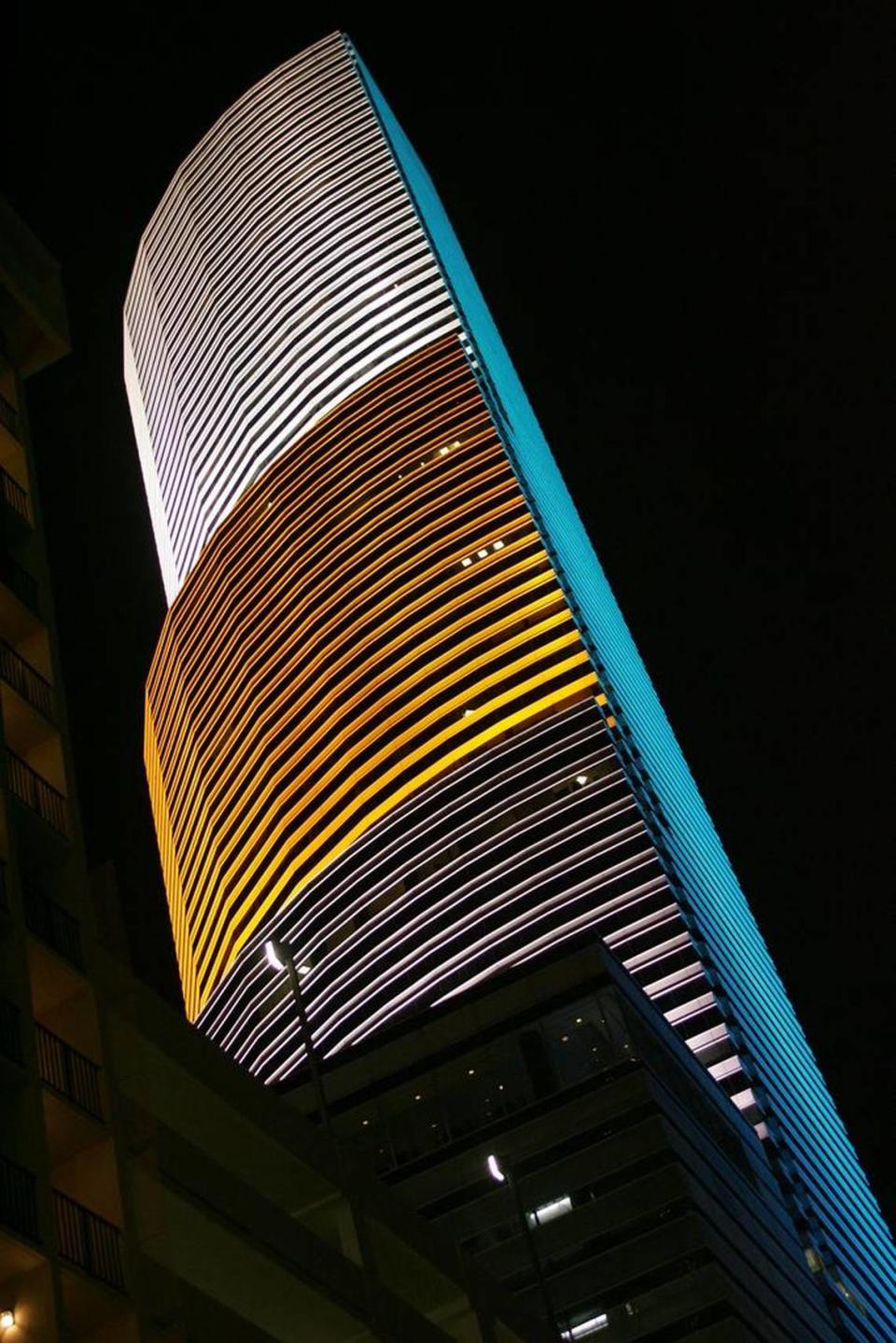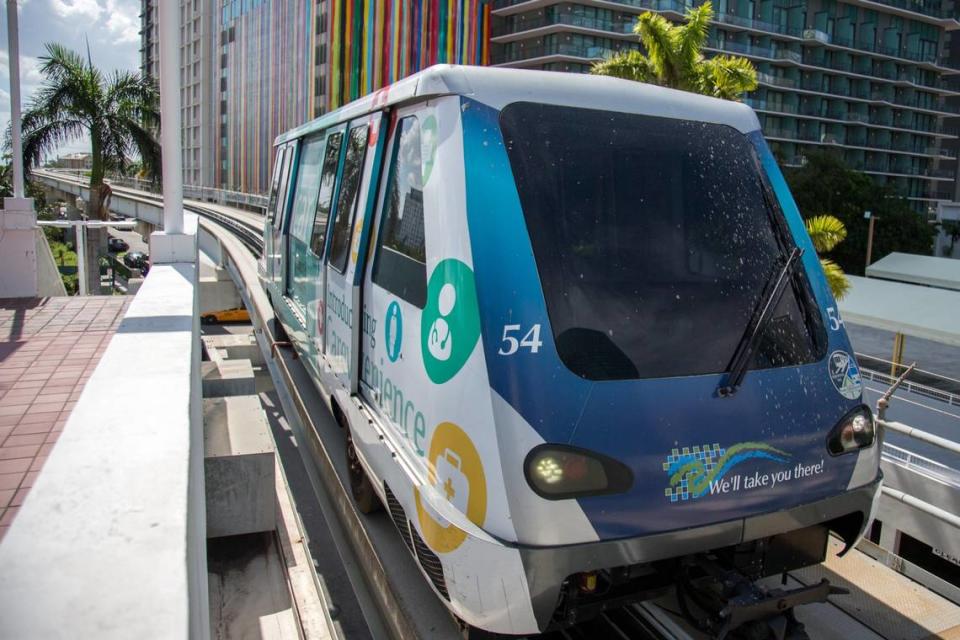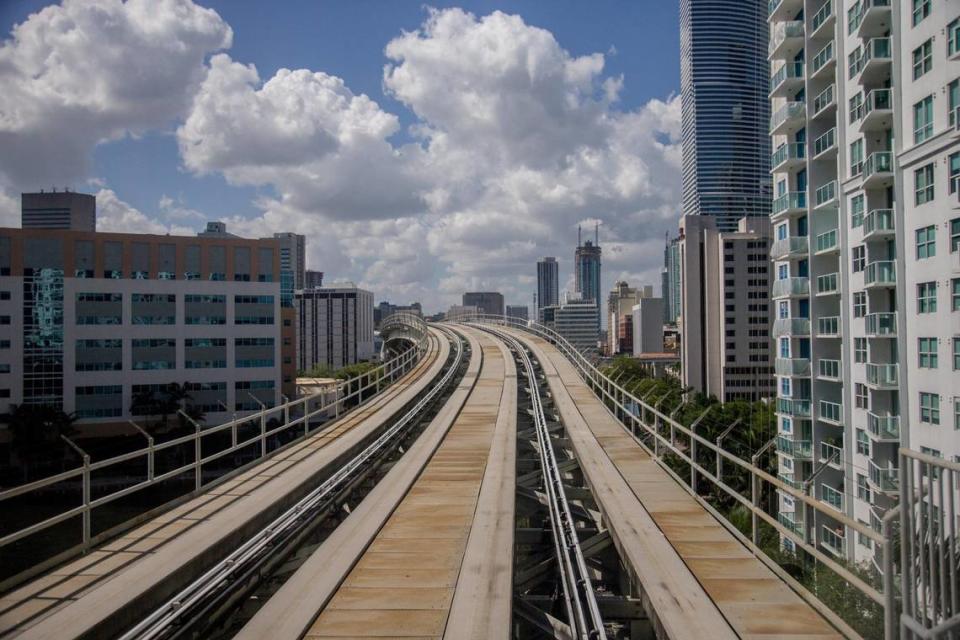Miami flyover to shut down Metromover for hours. What’s next for the transit system?
Update: Days after announcing that the Inner Loop would be closed for more than a year, Miami-Dade County officials changed course on Friday and said there is currently no long-term closure planned. This article has been updated to reflect the new information.
A helicopter flyover to drop off materials on the roof of the Miami Tower in downtown Miami will shut down the Metromover for 11 hours and require intermittent road closures on Saturday, according to authorities.
All Metromover stations are expected to open Saturday at 4 p.m., 11 hours later than usual, Miami-Dade County’s Department of Transportation and Public Works announced. Normal service hours are 5 a.m. to midnight, seven days a week.
Free bus shuttle service between stations will be provided until service resumes, the department said.
The disruption will affect thousands of people who ride the Metromover on Saturday. About 18,000 people ride Metromover on a given Saturday, according to the county’s most recent transit report. During an average weekday, that figure increases to nearly 23,000.
Nearly 7 million people stepped into a Metromover car in 2023, a 25% increase compared to the previous year, Miami-Dade County said.
Saturday’s shutdown is just one of several that have beset Metromover in recent weeks The Inner Loop, which shortens ride times for people moving through eight stations in downtown Miami, was closed intermittently between Jan. 20 and Feb 6 due to maintenance issues, a county spokesperson confirmed.

Matt Molina, 25, who works downtown and mainly uses the Inner Loop to go to lunch, was one of those impacted by the recent closures.
“I just take the Full Loop and make my way around,” said Molina, of Hialeah. “When it breaks down, it takes me longer to go back to work and it leaves me without enough time to eat.”
Molina was riding in an Inner Loop car on Thursday, which had a door that would not open fully.
“All I want is for the Metromover to not break down as often and for them to get new trains,” Molina said. “As you can see, the train door doesn’t even open completely.”
In addition to Saturday’s Metromover closure, several downtown Miami streets will be closed due to the helicopter flyover.
Southeast Second Street, between Miami and Second avenues, and First Avenue, between Fourth and Second streets, will shut down for 15 to 20 minutes at a time from 7 a.m. to 4 p.m., Miami police said.
The flyover is needed to make building improvements at Miami Tower, 100 SE Second St., the former CenTrust Tower, where Metromover’s Knight Station is located. The building improvement plan is not a county project, the county said.

Administrators of the Miami Tower, a 47-story office skyscraper known for its glass tiers and color-changing light installations, did not immediately say how the building is being improved. However, according to the city of Miami’s Building Department, the tower has an active permit for a cooling tower, a $1.5 million project.
Because the helicopter will make several flights over the Metromover tracks, the Federal Aviation Administration requires the public transportation system to be shut down until the job is completed, Juan Mendieta, a spokesman for the county’s Transportation and Public Works Department, told the Miami Herald.
A Metromover contractor “will further advance work” on a project to upgrade the train’s operating system, tracks and central control center during the hours-long closure, the department said.
The previously postponed helicopter flyover (not a County project) to the Miami Tower roof for materials drop off is rescheduled for Saturday, February 10, 2024. 1/2 pic.twitter.com/dG1kCVFfwZ
— Miami-Dade Transit (@IRideMDT) February 6, 2024
What’s next for the Metromover?
Earlier this week, the county announced on X, formerly Twitter, that the Inner Loop would be shut down over 12 months “to replace major systems and test upgraded vehicles.”
But on Friday, after riders took to social media to complain about the proposed year-long closure, the county’s Transportation and Public Works department announced on X there is no plan for a long-term shutdown of the Inner Loop.
“As part of our Metromover Upgrade Project, a potential closure of the Inner Loop is being reviewed to significantly improve service and extend the lifespan of a system that has been in service for over 30 years,” the agency said.
We will communicate key dates to riders with ample time. The only planned short-term closure will occur on Saturday, Feb. 10. The entire Metromover system will be closed for service until 4 p.m. due to a helicopter flyover to the Miami Tower roof, 3/4
— Miami-Dade Transit (@IRideMDT) February 9, 2024
The $150-million project will reduce service disruptions, wait times and maintenance costs, extending the lifespan of Metromover, built in 1986, by an additional 30 years, officials say. It is scheduled to be completed in 2025, according to the county’s website.
Metromover, which includes two routes or loops — Full and Inner — takes people free of charge through several stops in downtown Miami and Brickell, but riders have experienced service disruptions in recent years.

Rebecca Arcia, 33, said she drives from Kendall to the Dadeland Metrorail station, where she boards the train to the Government Center stop in downtown Miami to go to work. Like Molina, she rides the Metromover’s Inner Loop to eat at restaurants during her lunch break.
“In December, my colleagues and I got off at Bayside to go to a restaurant there, and when we came back the Loop was broken, so we decided to walk,” Arcia said. “It’s easy to use, but when it breaks down it’s confusing.”
Ricardo Murrieta, 30, said he uses Metromover to go to work for a tour company near Bayside Marketplace. The Little Havana resident said the Miami train service is better than what he has experienced in other cities.
“Honestly, I’ve gone to other cities and their trains are not as efficient as in here,” Murrieta said. “The Metromover is free and its train stops and cars are clean.”

But Murrieta has also learned to adapt, using the GO Miami-Dade Transit mobile app to receive service interruption alerts, sometimes leaving earlier than usual to get to work on time.
“The app alerts me when the Inner Loop is not working,” Murrieta said. “For the people who don’t know, it’s more complicated.”

